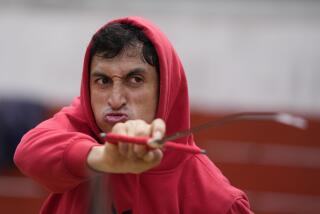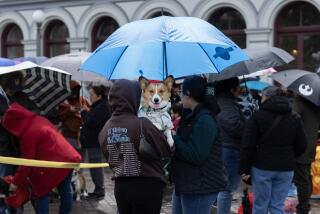Spanish Festivals Criticized as Barbaric
- Share via
MADRID — A summer of fiestas in which a man was killed, several were gored and animals were tormented or slain has lent strength to allegations that some of Spain’s traditional festivals are barbaric.
“This has been a horrible year; the regulations are being totally ignored,” said Consuelo Polo, spokeswoman for the National Assn. for the Defense of Animals.
A national law bans the use in fiestas of any animals except bulls and cows, which are considered essential to the rituals, but it has been applied by only five of the country’s 17 regional governments.
Although regulations protecting both human and animal participants in fiestas are strict on paper, few appear to be enforced.
At some fiestas, people stick balls of tar in the tips of bulls’ horns and set them afire. At others, horsemen tear the heads from geese suspended by the feet from ropes.
Julio Caro Baroja, an anthropologist, said the rituals were born in the turbulent years after Jews and Muslims were expelled from Spain at the end of the 15th Century. According to Caro, the animals assumed the role of the enemies of pure, Roman Catholic Spain.
Most criticism from the press and animal-rights activists is directed at the running of bulls and cow-baiting. Both have been highlights of town festivals for decades, and in some cases centuries.
In the bull runs, or encierros , animals to be fought by matadors in the afternoon are stampeded through cordoned-off streets at dawn, with hundreds of men running ahead to test their bravery after a night of revelry.
Pamplona’s encierros , made famous by Ernest Hemingway’s novel “The Sun Also Rises,” are the most popular and the model for many others. They also are the best supervised, but still, dozens of runners are injured every year during the eight-day celebration.
In less perilous vaquillas , six cows are set loose in pairs in a bullring and taunted by youths, many of whom are drunk.
More than 60 people were injured during a three-day fiesta in August at Leganes, a Madrid suburb, including a 24-year-old gored in the groin by a young bull. The man had lost a testicle in a goring last year.
At San Martin de la Vega, a small central town, chemical foam was pumped into the plaza as a fillip to a nighttime vaquilla . It engulfed two calves and asphyxiated them.
According to the animal-rights group, the Madrid region is the best example of lax enforcement.
“Mayors do whatever they want and the people literally do the most awful things to the animals,” said Polo, the spokeswoman.
The Madrid regional government, controlled by the Socialist Party, sent circulars to towns in the summer urging them to observe the laws. The opposition Popular Party also made an appeal.
Gabriela Cana of the national newspaper El Pais said a study it conducted found that few towns, if any, complied with all regulations for the runs, including a requirement that someone experienced in handling bulls be on hand in case of emergency.
“Oscar Martin died in Torrelaguna simply because there was no expert to distract the animal away from him, as the law requires,” she said in a telephone interview.
The man allegedly chosen for the task said later he knew nothing of the assignment, she said.
Town officials readily admit that the rules are violated, but cite enormous pressure from local people who fiercely protect the traditional rituals.
Many officials acknowledge that irregularities occur, but deny that the situation is out of control.
“You must keep in mind that the laws are attempting to regulate very spontaneous fiestas that are heartfelt in Spain and not often understood abroad,” said Maria Victoria San Jose, an adviser to the Interior Ministry.
More to Read
Sign up for Essential California
The most important California stories and recommendations in your inbox every morning.
You may occasionally receive promotional content from the Los Angeles Times.










